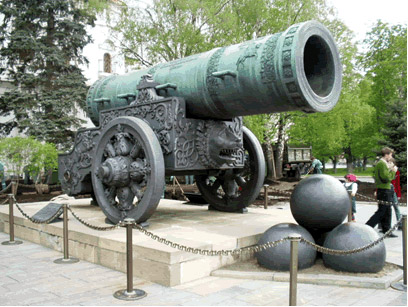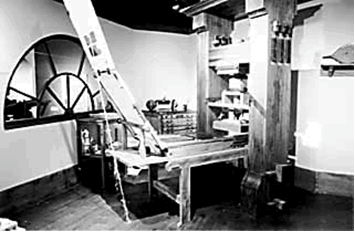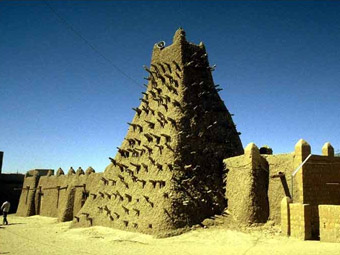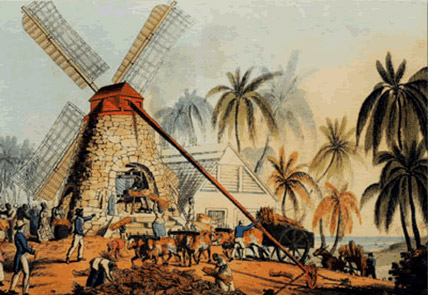|
|
||||||||||
|
||||||||||
|---|---|---|---|---|---|---|---|---|---|---|

|
||||||||||
The Great Dying and its consequences. In the Western Hemisphere, the demographic collapse among Native Americans was catastrophic in places that had large populations on the eve of European contact. These places included the Caribbean islands, central Mexico, the Mayan highlands of southern Mexico and central America, and the Andes Mountains. The Great Dying involved multiple infectious diseases and ferocious pandemics that followed one after another for more than a century and a half. It began when new disease pathogens were inadvertently introduced to American Indian populations by early Spanish and Portuguese invaders. Owing to the long separation between the western and eastern hemispheres, the populations of the Americas had not evolved significant natural immunities to Afroeurasian infections, which included measles, smallpox, influenza, typhus, and tuberculosis. Therefore they had no inherited defenses against them. In this perspective, the epidemic diseases can be seen as part of the Columbian Exchange of numerous organisms, including plants and animals. The Great Dying caused massive social, economic, and cultural upheaval in numerous Amerindian societies. This was probably the major factor in the disintegration of the Aztec and Inca empires. The calamity also had a major impact on the development of the new Spanish empire in the Americas. The population loss meant that the Spanish faced severe shortages of labor and rapidly shrinking taxes. They therefore had to create an administrative system that gave priority to the mining industry and ensured the continued export of silver. Another consequence was the creation of social and legal institutions to force surviving Indian men and women to work for Europeans in mines and commercial agriculture. The Great Dying, however, was just one aspect of the many ecological transformations that resulted from the Great Global Convergence. The arrival of Europeans in the Americas transformed the natural environment because the newcomers brought with them new organisms of all types, including many new food plants, several domestic animals (of which Native Americans had few), and numerous species of weeds. Because America’s pre-existing biota was often unable to compete successfully with these invading species, much of the Western Hemisphere’s environment came within several centuries to resemble the environment of northwestern Europe. In 1500, for example, wheat was unknown to peoples of North America. After European wheat-eaters introduced this crop to the North American temperate climate (which was not radically different from Europe’s climate), it became a staple of the diet of most of the population. The same was true for the populations of the southern cone of South America.
The African slave trade. The Great Dying also set in motion another process: the forced migration of millions of African men and women across the Atlantic. This was because in order to keep the mines, plantations, and haciendas producing for the European market, European mine and estate owners had to find more labor. Because of the Great Dying, European entrepreneurs were frequently unable to find the local Indian labor they wanted, while free Europeans were unwilling to cross the Atlantic in large numbers to take up back-breaking jobs and expose themselves to tropical diseases. In order to continue making handsome profits from production and sale of sugar, silver, and other commodities, they brought in African slaves. From a sugar planter’s point of view, African slaves—plentiful, cheap, and usually experienced at farming—were a practical solution. Between 1450 and 1810, perhaps 11 million enslaved Africans arrived in the Americas. European sea merchants contracted with African rulers and traders to sell them captured Africans who had been enslaved by fellow Africans in their homelands. Historians have estimated that 42 percent of these enslaved men and women were sent to the Caribbean, 38 percent to Brazil, and only 5 percent to North America. The slave trade was disastrous for tropical Africa as a whole. African slave traders aimed to capture and sell mainly young women and men because they were the age group best fit to work and reproduce. The trade therefore drained African societies of their most productive people. The population of sub-Saharan Africa in 1900 was about 95 million. If the trade had not occurred, it would likely have been much higher. Between 1500 and 1800 the proportion of men and women of African origin in the Americas steadily grew. From a demographic perspective, the hemisphere was becoming increasingly “Africanized.” During the same period, a second major migration, this one voluntary, further altered the population profile of the Americas. Between 1500 and 1800 about 2 million Europeans traveled to the Western Hemisphere. Europeans, however, still constituted a minority of the population in most parts of the Americas as late as 1800. It was only in Big Era Seven that the demographic “Europeanization” of the Americas really took off. Rampant deforestation. Big Era Six witnessed a sharp increase in world deforestation, notably in Europe, the Americas, and Japan, an exploitation that also involved erosion, flooding, and climate change. The chief cause was the expansion of mining worldwide. This industry required vast quantities of wood, both fuel for smelters and timbers for mine shafts. This led to the deforestation of entire regions around the major mining sites. Silver and mercury mining in Japan and Latin America, notably Potosí and Huancavelica in the Peruvian Andes and Zacatecas in central Mexico, was especially destructive. Mining also significantly decreased forest cover in England, northern France, and central Europe. The energy demands of the sugar industry in Brazil and the Caribbean, where biomass (wood) energy was needed to fire sugar boilers, produced extensive deforestation. Naval construction, which boomed during this period, was another major source of deforestation. The demands for ships’ timbers, masts, and spars placed a severe strain upon the forests of the Baltic and New England, as well as those of the Indian Ocean rim, where vessels for the Asian trade were constructed. Western Europe and Japan underwent profound energy crises in the seventeenth century due to deforestation. In Europe, the shortage of wood energy occasioned a search for alternative sources, provoking the shift to fossil fuels, initially coal. In Japan, by contrast, the wood crisis led to an ambitious reforestation project. This said, we must note that most of the switch from biomass to fossil fuels occurred in the subsequent Big Era.
|
Sugar, an Afroeurasian crop cultivated in the Americas, and the seeds of the cacao, an American plant introduced to Afroeurasia, are the key ingredients of chocolate. Photo by Ross Dunn |
 |
|---|
Sugar itself had a transforming effect on the Atlantic world in Big Era Six. The sugar boom brought riches to some Europeans and Africans but a death sentence to many others. The swelling consumption of sugar, coffee, tea, and cacao transformed the diets and daily habits of ordinary Europeans and linked them by invisible economic threads to enslaved Caribbean and Brazilian workers. The silver mines and sugar plantations did much to create a new international division of labor in which Africans, Native Americans, and Asians increasingly supplied labor and raw materials, while Europeans made finished goods using complex technologies.
Revolution in military power and finance. A primary reason for the rise of European power was the military and fiscal revolution. In the military sphere, Europeans adopted gunpowder weaponry, which had originally been pioneered in China. This soon led to advances in strategy, tactics, fort-building, and discipline. Warfare became the business of professional soldiers and sailors. Europeans fought many wars during this Big Era. These conflicts included the Wars of Religion, the Puritan Revolution in England, the Seven Years’ War, the American War of Independence, and the French Revolution. Military innovations, however, did not serve all European states equally because some states augmented their power at the expense of others. By 1800, Britain had virtually eliminated France, its principal rival for global domination, from North America, the Caribbean, and South Asia.
The ”Tsar Cannon.” The emperor of Russia ordered the casting of this gigantic bronze cannon in 1586. Its tube weighs 40 tons. It was intended for defense of the Kremlin in Moscow, but it was never fired. Photo by Ross Dunn |
 |
|---|
The military revolution was also fiscal because it required deep changes in state bureaucracy, taxation, and accounting to pay for increasingly expensive wars. In this race for revenue only the fiscally fit survived. The power of states unable to finance costly artillery and other weapons was gradually reduced by their more successful rivals. Britain’s greater ability to finance warfare largely explains its victories over France. For example, French military and financial support for the American Revolution led to that kingdom’s bankruptcy and thus contributed to the French Revolution, to be discussed in Big Era Seven. In Asia, imperial states like the Ottomans, Mughals, and Ming Chinese adopted gunpowder weapons and expanded their territories. They did not, however, accept the full package of military and fiscal reforms that Europeans did. By the later eighteenth century, the balance of military power in the world was shifting to the European side.
Before the nineteenth century, European states did not have a significant military advantage over Asian or African rivals. For example, at the start of the era, the Austrian Hapsburg empire (the largest in Europe) could not defeat the Ottoman Turkish empire, its principal rival. The Portuguese, Dutch, and English traded for slaves in West Africa but seized little territory because regional African states, which were increasingly armed with guns, had sufficient power to defend themselves. The tropical disease environment in West Africa was also deadly to Europeans. It was not until the nineteenth century that Europeans began to have adequate military and medical technology to readily defeat Asian or African armies. At the start of Big Era Seven, for example, both Austrian and Russian forces deploying massed field artillery and other lethal weapons were able to defeat the Ottomans more and more often.

Humans and Ideas 
In Big Era Six, Europe emerged as a center of technological and scientific advance, a hotbed of ideas and inventions that contributed greatly to the building of denser networks of human interaction. It is important to note, however, that Europe enjoyed this role only because its thinkers and experimenters were able to build on the legacy of scientific and technological exchanges that had been part of Afroeurasian history for several millennia. As we have suggested in the discussion for the previous Big Eras, between the eighth and fourteenth centuries, a new synthesis of Arab, Persian, Mesopotamian, Greek, and Indian knowledge about nature, society, and the cosmos gradually appeared. Beginning in the twelfth century, Europeans gradually adopted this synthesis of learning and increasingly contributed to it.
A self-portrait of Sofonisba Anguissola, 1531-1626. This Italian Renaissance artist was painter to the royal court of the Emperor Philip II of Spain. Women Artists California State Polytechnic University, Pomona http://www.csupomona.edu/~plin/women/womenart.html |
 |
|---|
Cultural developments in Europe. Europe’s transformation was also the product of internal cultural trends. Following its recovery from the devastating plagues, climatic deterioration, and warfare of the fourteenth century, Europe underwent a multi-dimensional revival. Its most visible cultural sign was the Renaissance, a flowering of art, literature, philosophy, and science centered in (and paid for by) royal courts and wealthy men and women in Italy and, a bit later, in northwestern Europe. The Renaissance was a cultural expression of Europe’s new prosperity, and it was fed by the new knowledge that poured into the region in the wake of European explorations and conquests across the oceans. In world terms, however, the Renaissance was not a major cultural turning point. Rather, it raised the level of sophistication and refinement of European elite culture to that of urban societies in the rest of Afroeurasia. A more decisive transformation was the Scientific Revolution that came in the seventeenth century.
A Replica of Johannes Gutenberg’s Printing Press of 1450. Museum of Printing History, Houston, Texas http://www.printingmuseum.org photo by Gerald E. McLeod “Day Trips,” The Austin Chronicle Feb. 2, 2001. |
 |
|---|
One critical innovation was the printing press and the use of movable type, which Johann Gutenberg (1394-1468) pioneered in Europe in the late fifteenth century. Printing using movable type had existed for many centuries in East Asia. Korean artisans invented the use of metal movable type, as opposed to wood or ceramic type, about the same time that Gutenberg was experimenting with movable type. This technology, however, caught on especially fast in western Europe. Printing stimulated literacy among middle- and upper-class Europeans, a growing market for ideas, including new conceptions of nature, the cosmos, and human society.
The spread of Protestantism was a major development linked to printing. The Protestant Reformation was a movement of religious protest and reform that burst on the European scene in the early sixteenth century. Martin Luther (1483-1546), a German Christian monk, challenged the Roman Catholic Church to make numerous reforms in doctrine and leadership. The result was a long and bitter struggle for religious and political power that divided western Europeans for well over a century. At the same time, the Catholic Church continued to gain followers, and a variety of Protestant churches sprang up, the forerunners of modern denominations such as the Lutherans, Presbyterians, Methodists, Episcopalians, and Baptists.
The Djinguareben mosque in Timbuktu, Mali, West Africa. Anonymous World Images Kiosk, San Jose State University http://worldimages.sjsu.edu©Kathleen Cohen. |
 |
|---|
The global religious scene. European merchants, soldiers, and missionaries also took Christianity, both Catholic and Protestant, around the world, leading to its rapid spread, especially in the Americas. Islam, an alternative vision of belief in one God, also continued to expand across Afroeurasia, carried along the overland routes and long-distance sea lanes. While Christianity was sinking deep roots in the Americas, Islam gained millions of new adherents in West Africa, East Africa, southeastern Europe, Inner Eurasia, India, and Southeast Asia. Buddhism continued to grow in China, Japan, and Southeast Asia.
However, the major organized faiths—Christianity, Islam, Buddhism, Daoism, Hinduism, and Judaism—had nothing like a monopoly on religious belief and practice in the world. Many believers in the major religions knew very little about the formal doctrines of their own faiths. They lived, rather, in a world dominated by beliefs in magic and spirits. Local, polytheistic religions declined on a world scale but continued to thrive in more remote places. Also, faiths involving syncretism, which means the meshing of beliefs and rituals of different traditions, became more common as the web of human interactions around the world tightened.
The Scientific Revolution. In Europe, the fragmenting of religious doctrine that accompanied the Protestant Reformation, the sudden linkup with the Americas, and the continuing flow of knowledge from distant parts of Afroeurasia produced multiple shocks to the Christian worldview. Such newness and change provoked a searching examination of the place of humans in the cosmos and nature. In the absence of any single controlling religious authority to stop them, scholars like Copernicus, Galileo, Descartes, Pascal, and Newton put forward philosophical and scientific ideas that challenged older ways of thinking.
Most important, they argued that the universe operates according to natural laws, which human reason and careful observation may discover and explain. The resulting Scientific Revolution was in many ways the logical outcome of Afroeurasia’s total legacy of scientific and philosophical creativity. It was also, however, a dramatic break with the long world trend to rely mainly on priests, spiritual sages, and other religious authorities to explain all things. In the eighteenth century, the Enlightenment, a great debate over the relative merits of science and faith as the proper measure of reality, gathered steam in Europe and began to penetrate other parts of the world.
Teaching Units for Big Era Six
Definition of Panorama Teaching Units
6.0 |
The Great Global Convergence |
PowerPoint Overview Presentation: |
Complete Teaching Unit Download Options:
|
Definition of Landscape Teaching Units
6.1 |
Oceanic ventures and the joining of the continents |
Complete Teaching Unit |
|
|---|---|---|---|
6.2 |
The Columbian Exchange and its consequences |
Complete Teaching Unit |
|
6.3 |
Rulers with Guns: The rise of powerful states |
Complete Teaching Unit |
|
6.4 |
The global economy takes shape |
Complete Teaching Unit |
|
6.5 |
The Making of the Atlantic Rim |
Complete Teaching Unit |
|
6.6 |
The Scientific Revolution |
Complete Teaching Unit |
|
| 6.7 | The Long Reach of the Major Religions 1500-1800 CE |
Summary of Teaching Unit | Complete Teaching Unit |
Definition of Closeup Teaching Units
3.2.5 |
Korea |
||
6.6.1 |
Leaders of the Enlightenment |
||
6.7.1 |
The Protestant Reformation |
Footnotes:
1 Christian, Maps of Time, 344-45.
Note:
Documents in Portable Document Format (PDF) require Adobe Acrobat Reader 5.0 or higher to view, download Adobe Acrobat Reader.
Documents in Powerpoint format (PPT) require Microsoft Viewer, download powerpoint.
Documents in OpenOffice format (ODT) require Oracle OpenOffice, download Oracle OpenOffice.
Documents in Word format (DOC) require Microsoft Viewer, download word.
|
World History for Us All is a project of the UCLA Department of History's
Public History Initiative, National Center for History in the Schools. Project Support | Conditions of Use |
